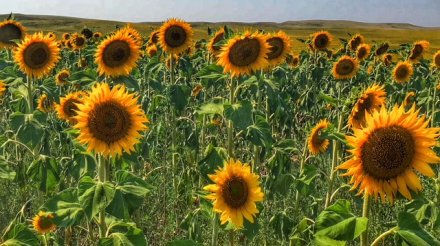 Finishing our travels in North Dakota with stops in Bismarck and Amidon, we continued to marvel at the vast amounts of hay bales in acres and acres of pastures — but were also pleasantly surprised to see acres of sunflowers, later learning that North Dakota is the leading producer of sunflowers in the United States; about 90 percent of all land in the state is farm or ranch land. By the way, the state is also the leading honey producer — and we certainly saw many, many bee boxes in our travels as well.
Finishing our travels in North Dakota with stops in Bismarck and Amidon, we continued to marvel at the vast amounts of hay bales in acres and acres of pastures — but were also pleasantly surprised to see acres of sunflowers, later learning that North Dakota is the leading producer of sunflowers in the United States; about 90 percent of all land in the state is farm or ranch land. By the way, the state is also the leading honey producer — and we certainly saw many, many bee boxes in our travels as well.
From our stop in Medora and Theodore Roosevelt National Park, we traveled to Bismarck, mostly because we have enjoyed following the long journey of Lewis and Clark — and have now followed their return route from the Pacific Coast to the Missouri River. (Fun fact: The Corps of Discovery spent the most time in what is now North Dakota than any other area, partly because of their wintering in Fort Mandan.) It was also the farthest east we will be on this leg of the trip — and the only days spent on central time.
 We had some thoughts of visiting the Lewis and Clark Interpretive Center in Washburn, North Dakota, but feared that the long drive there would not garner us any new information on the Corps of Discovery that we had not already learned. That said, it is most certainly a worthy stop for many.
We had some thoughts of visiting the Lewis and Clark Interpretive Center in Washburn, North Dakota, but feared that the long drive there would not garner us any new information on the Corps of Discovery that we had not already learned. That said, it is most certainly a worthy stop for many.
Instead, we decided on taking a sunset riverboat cruise on the Missouri, following the great Lewis and Clark journey — in a sternwheeler riverboat aptly named the Lewis and Clark Riverboat. While the narration was a bit lacking in both quality and sound, and the river itself not all that pretty, it was indeed cool to cruise where those explorers had cruised — and the sunset made the day for us!
While in Bismarck, we also got out on our bikes and enjoyed the Hay Creek Trail, which winds its way through a native creek area — and is a nice haven in the middle of the city. The trail is mostly asphalt, and good for biking or walking.
We concluded our time in North Dakota — back in mountain time — in the tiny county seat of Amidon, partly chosen for its location near the highest point in the state, and partly because of our 150-mile rule (in which we try to never travel more than 150 miles between campgrounds).
 In a state as flat as North Dakota, it was fun to think about hiking up to the highest point in the state… and the hike to White Butte (also near sunset to avoid some of the blistering heat we have been encountering), at an elevation of 3,506 feet, was truly a fun and fairly easy hike, coming in at just under 4 miles roundtrip from the trailhead. The trail is on private land, but open to the public. The area around the butte was carved by glacial flows thousands of years ago, but because the glacial ice sheets did not cover the surface of the butte, it remained standing while the rest of the land was washed away.
In a state as flat as North Dakota, it was fun to think about hiking up to the highest point in the state… and the hike to White Butte (also near sunset to avoid some of the blistering heat we have been encountering), at an elevation of 3,506 feet, was truly a fun and fairly easy hike, coming in at just under 4 miles roundtrip from the trailhead. The trail is on private land, but open to the public. The area around the butte was carved by glacial flows thousands of years ago, but because the glacial ice sheets did not cover the surface of the butte, it remained standing while the rest of the land was washed away.
Next up? A road trip through four states (North Dakota, South Dakota, Montana, Wyoming) so that we can have a close encounter with Devils Tower National Monument!
